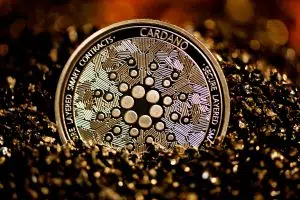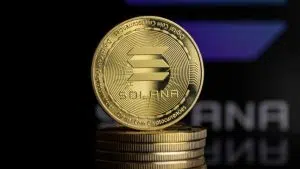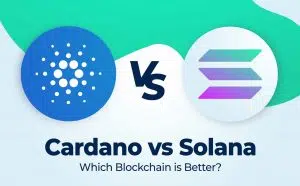Contents
Cardano and Solana are nicked named the Ethereum killers and for good reasons. Both cryptocurrencies have managed to proactively utilize their Proof of Stake (PoS) and other methods that will be discussed to solve Ethereum’s scalability issue.
The world of cryptocurrency and blockchain is hardly a one-pony race, with thousands of altcoins in the run to be the best coin in the game. Solana and Cardano are two such coins. Both coins have done the unthinkable. They are active threats to the blockchain behemoth, Ethereum.
There is a lingering problem in the world of cryptocurrency, and that problem is scalability. This is precisely the problem that Solana and Cardano solve with their respective Proof of stake (PoS) models. While these projects gave up the head start advantage, each took the time to perfect a particular aspect of their model that is now setting them apart from their competition. Those features will be critically analyzed in the article below, and a question that has plagued crypto investors for years will finally be answered.
The brand new newsletter with insights, market analysis and daily opportunities.
Let’s grow together!
Which coin is better?
Cardano Vs. Solana
The decentralized finance ecosystem (DeFi) is a significant foundation of the blockchain world. To many investors, a coin’s ability to contribute to this ecosystem is their crucial value point. Cardano and Solana have both proved their value to their respective blockchains. Each has advantages and disadvantages that set it apart in a sea of competitors. These coins have been cast as rivals since their introduction, much like Ethereum and Bitcoin are often positioned in direct opposition to each other. Cardano and Solana have been painted as potential Ethereum killers because of their distinguishing features.
Solana excels in a way that no other coin can compete with. Speed. Solana has achieved one of the fastest transaction times and subsequent lowest fees in the popular crypto market. This makes it very attractive for people trying to profit from the blockchain economy. Cardano, however, has moderately fast transactions, but this is not the project’s priority. This coin succeeds in its security against the DeFi ecosystem’s greatest threat, cybercrime. As far as the major currencies are concerned, you’d struggle to find a more secure coin.
But one question remains, which coin is best?
What is Cardano?
Cardano has scaled the hierarchy of the blockchain world. It did so with its stead and thoroughly implemented proof-of-stake (PoS) validation mechanism. This blockchain is powered by its native coin, ADA.
A startling fact about the Cardano blockchain is perhaps a contributing factor to its significant success relative to the Ethereum blockchain. The creators of this blockchain and its native cryptocurrency token ADA were co-founders of the Ethereum network. They disagreed with the roadmap of the Ethereum network and set out to develop a blockchain network that aligned with their vision for the DeFi ecosystem. This roadmap also reveals that its token availability cap is at 45 billion.
Hoskinson and Wood overcame many issues they explicitly found in the Ethereum network. It does this by employing its proprietary validation mechanism. Its Proof of stake protocol is the most secure of its kind, and it’s called Ouroboros. Another factor that increases its uniqueness is that it is the first blockchain protocol to incorporate peer-reviewed research. This mechanism is also validated by holders of the blockchain’s native token, ADA. It even rewards these coin holders for validating the network. All of this makes for a network far more secure than the Ethereum network has ever hoped to be, considering its vulnerability to blips in its network.
Cardano’s is not a perfect blockchain network, but it will be the first to acknowledge its flaws. The project prioritizes thorough strategy and deliberate implementation. Therefore, its developers have laid out a roadmap for the future of Cardano that spans five phases. Who knew the crypto space would employ similar release strategies to the Marvel cinematic universe?

Cardano’s pros and cons
| Pros | Cons |
| The Ouroboros Proof of State mechanism reduces its network’s energy consumption by 99% | It is slow compared to competitors like Solana.
|
| ADA has had a 3900$ ROI since 2017 | Its extended UTXO accounting method, the same model used by Bitcoin, is highly criticized.
|
| The Cardano network’s block accommodates 250 transactions per second (TPS) | The project is unfinished.
|
| Low transaction fees: 0.1 ADA per transaction | The ADA is potentially overvalued
|
| It is very secure and prevents vulnerabilities to hackers. | |
| Almost 100% decentralized network |
What is Solana?
The Solana blockchain network is open-source and utilizes its native cryptocurrency token SOL. The network facilitates the deployment of Decentralized apps (Dapp) and the execution of smart contracts on the Solana blockchain network.
Solana uses the widely accepted proof of state (PoS) mechanism but uses one other validation method. It is the only blockchain on the DeFi network to utilize the Proof of History (PoH) validation methods. The combination of these validation methods validates the transactions on the blockchain by timestamping the transactions. In addition, it preserves the sequences of orders on the Solana blockchain.
Its speed of transactions has set this blockchain network apart from every other popular cryptocurrency. This is essential to why SOL is the second most popular cryptocurrency used to mint and trade NFTs, second only to Ethereum. Its TPS has also inspired crypto investors to take notice. The Bank of America even claimed that Solana had the potential to become the VISA of digital goods and services.
The Solana blockchain network has experienced substantial adoption since its launch in 2020. It has processed over 50 billion transactions since its release. It has also facilitated the minting of 5.7 million non-fungible tokens (NFTs). The network and its native token, SOL, are optimized for the gaming industry and financial technology. The network has a bright future ahead.

Solana’s pros and cons
| Pros | Cons |
| Fast transaction fees: 50000 TPS | The Solana network is vulnerable to cybercrime.
|
| It facilitates the minting of NFTs. | Solana does not have many active projects on the network.
|
| The Solana network allows for the deployment of Dapps (decentralized apps) and smart contracts. | Solana does not have an SOL supply cap and is subject to inflation.
|
| It has a low environmental impact. | It is still somewhat centralized.
|
Cardano vs. Solana: which cryptocurrency is the best buy
Cardano and Solana are prominent contenders in the blockchain network. They have been crowned the “Ethereum Killers.” The developing teams of both projects were actively involved in the elopement of the original Ethereum network. They noticed apparent issues in how Ethereum was developed and sought a way to resolve those core issues throughout their projects. The critical issue addressed through these projects is the problem of scalability.
Cardano and Solana are worthy opponents to each other and utilize similar validation mechanisms. While Cardano uses its proprietary Ouroboros proof of stake model, Solana employs their Proof of stake mechanism. The latter also combines their Proof of stake mechanism with a compounding validation method, the revolutionary Proof of History (PoH). This allows Solana to validate the values attached to each transaction executed on its blockchain network and to timestamp each transaction as it occurs. Both validation strategies have helped the respective networks and native tokens excel in the DeFi space. They have also resulted in both networks having remarkably low transaction fees.
Solana is the victor, however, regarding transactions to transaction speeds. As far as the top tier of popular cryptocurrencies is concerned, Solana is the Speed Queen! The Solana network makes excellent use of its open-source software to encourage user activity. Despite the high transaction fees associated with changing the software, it has still allowed Solana to optimize itself to facilitate a user-friendly. As a result, Solana’s network of smart contracts, Dapps, and NFTs are positioned to threaten, if not entirely, to take over Ethereum shortly.
Cardano has taken a different developmental route compared to its above competitor. While it does boast impressive transaction speeds, speed is not the end goal for the Cardano network. Its primary focus since conception has always been security. This is an area that both Solana and the Ethereum network fall short in as they, along with bitcoin and various other altcoins, are highly vulnerable to cybercrimes and temporary network glitches. That is something that Cardano users do not need to worry about as their network employs two-layers defense protocols.
Therefore, if investors wish for easy access to fast transactions, Solana is the obvious choice. But if security is something you’re just not willing to put in the backseat, and you don’t mind a bit of a wait, Cardano Is the horse you should bet on.







